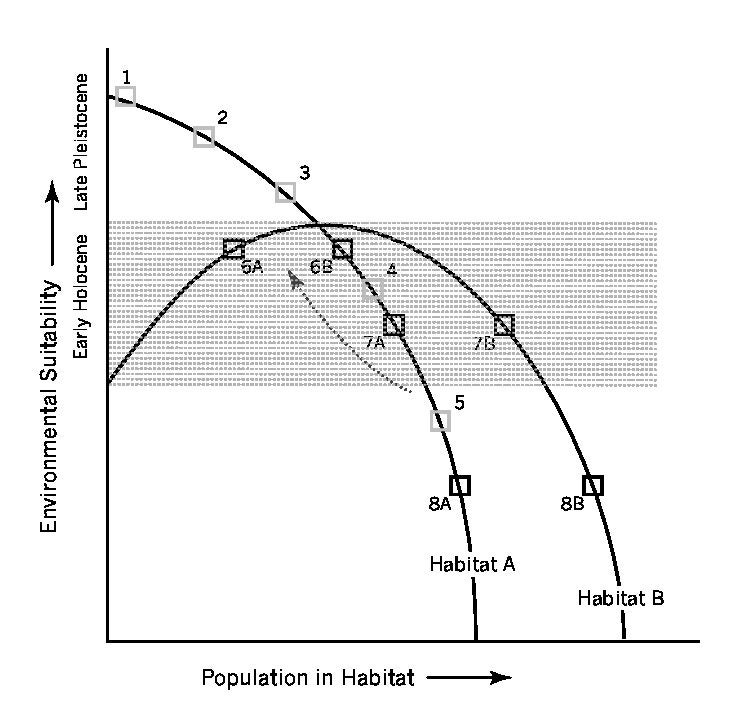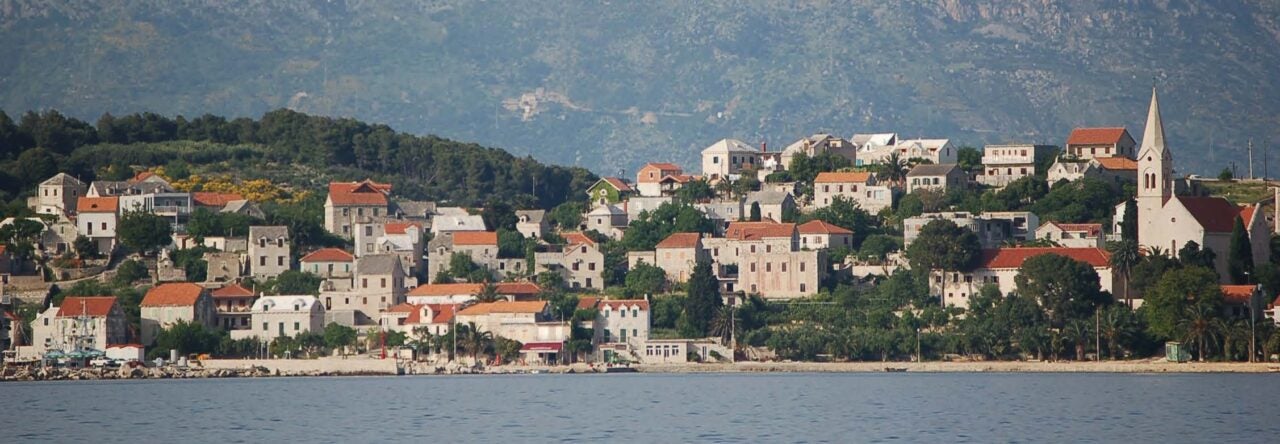The ideal free distribution (IFD, Figure below; Fretwell and Lucas 1969) predicts a knowledgeable colonizing population of foragers will settle first in the most suitable habitat (A, numeral 1). As population grows, competition & resource depletion reduce the suitability of A (numerals 2, 3 and 4). Before reaching 5, population will spill over into the newly attractive Habitat B (dotted arrow), the suitability of which initially increases with density. Economies of scale or a learning curve of skills acquisition would have this effect. Habitat B partially empties A; equilibrium is reestablished with both habitats settled at 6A, 6B. With further population growth, individuals continue to distribute themselves so to equalize their experienced but declining environmental suitabilities in both habitats (7A, 7B; 8A, 8B).

IFD representation of Schmuck et al. (2022) hypothesis about Prince of Wales Island (southeastern Alaska) colonization and settlement, Late Pleistocene/Early Holocene. The numerals trace population growth over time, the settler's experience of habitat suitability and their predicted distribution over the two habitats represented.
In a new study of Prince of Wales Island (PWI), Schmuck et al. (2022) propose the IFD scenario just described. Late Pleistocene colonists arrived as the coastal zone became ice free (~14,000 cal BP), settled first in either the inland terrestrial or coastal marine habitat, whichever was of highest suitability. Only later in the early Holocene did they occupy the second ranked habitat. The analytical results are supportive, but with a twist.
PWI watershed resources were evaluated using proxies for salmon (# species), caribou (level area for feeding) and shellfish (intertidal area). Following a methodology used also by Winterhalder et al (2010), Schmuck et al. then examined the earliest dates of each of 29 archaeological settlements and their habitat associations over time. Instead of a late Pleistocene expansion of settlement numbers exclusively in one habitat followed by a later movement into the other habitat, the archaeological record starts at ~10, 500 cal BP with clusters of settlements in both inland and coastal zones. The settlement evidence available captures IFD expectations after an initial in-fill (stippled area); an earlier, Late Pleistocene phase (gray-scale boxes 1-4), ~14,000 t0 10,500 cal BP, is implied but the record of it missing.
We can’t yet be c0nfident of the full IFD scenario, nor have we evidence indicating whether the interior or coastal habitat initially was the preferred, the A or the B. However, the IFD and PWI analysis point to earlier but currently undocumented sites required for the Pleistocene timing of the kelp highway hypothesis and sure to be informative about the forager adaptations that sustained it.
Fretwell, Stephen Dewitt, and Henry L. Lucas Jr. 1969. “On Territorial Behavior and Other Factors Influencing Habitat Distribution in Birds. I. Theoretical Development.” Acta Biotheoretica XIX:16–36.
Schmuck, Nicholas, Jamie L. Clark, Risa J. Carlson, and James F. Baichtal. 2022. “A Human Behavioral Ecology of the Colonization of Unfamiliar Landscapes.” Journal of Archaeological Method and Theory. doi: 10.1007/s10816-022-09554-w.
Winterhalder, Bruce, Douglas J. Kennett, Mark N. Grote, and Jacob Bartruff. 2010. “Ideal Free Settlement of California’s Northern Channel Islands.” Journal of Anthropological Archaeology 29:469–90.
